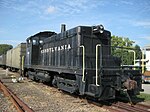Rolling stock
- Diesel locomotives
| Image | Operator | Road Number | Class | Model | Date | Notes |
|---|---|---|---|---|---|---|
 | Pennsylvania Railroad | 5888 | EP-22 | EMD E8 | 1951 | Undergoing restoration |
 | Pennsylvania Railroad | 9408 | ES-6 | EMD SW1 | 1950 |
- Passenger cars
| Image | Operator | Road Number | Class | Type | Manufacturer | Date | Notes |
|---|---|---|---|---|---|---|---|
| Pennsylvania Railroad | 6518 | BM70nb | Railway Post Office | PRR | 1912 | Fully equipped with sorting racks cancellation tables, parcel bins | |
| Pennsylvania Railroad | 6062 Juliet | B70A | Baggage car | PRR | 1928 | Used for the transportation of Theatrical scenery | |
| Pullman Company Pennsylvania Railroad | Waltersburg | Plan 3410A | 12-1 sleeping car | Pullman | 1924 | ||
| Pullman Company Pennsylvania Railroad | Cascade Gardens | Plan 4072B | 10-5 sleeping car | Pullman-Standard | 1939 | ||
| Pullman Company Pennsylvania Railroad | Cascade Heights | Plan 4072C | 10-5 sleeping car | Pullman-Standard | 1940 | ||
| Pullman Company Pennsylvania Railroad | Metropolitan View | Plan 4080A | 1-2 sleeper buffet-lounge-observation car | Pullman-Standard | 1938 | ||
| Baltimore and Ohio Railroad | 5503 La Paz | Coach | Pullman-Standard | 1949 | Built for B&O streamliner The Columbian | ||
| Baltimore and Ohio Railroad | 3315 Chicago | Tavern-Lounge-Observation car | Pullman-Standard | 1949 | Built for B&O streamliner The Columbian |